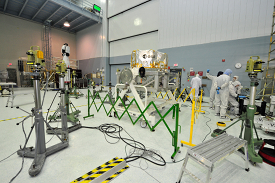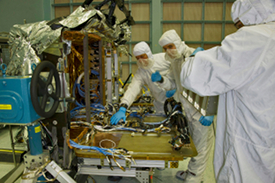#05: NIRSpec prepared for integration in ISIM
5 February 2014
The Near InfraRed Spectrograph (NIRSpec) on the James Webb Space Telescope (JWST) is being installed on the Integrated Science Instrument Module (ISIM) at Goddard in preparation for an extensive series of tests with the full instrument complement. In addition, new detectors have been selected for NIRSpec, to be installed later this year.After arriving at Goddard in September 2013 NIRSpec was unpacked and, as with any delivered item, underwent post-delivery inspections and tests. These all went smoothly and NIRSpec was officially handed over to NASA on 24 October 2013, however, ESA will remain responsible for the instrument until six months after launch.
NIRSpec, and the near-infrared camera NIRCam, are now being prepared for installation into the ISIM. The Fine Guidance Sensor / Near-InfraRed Imager and Slitless Spectrograph (FGS/NIRISS) and the Mid-Infrared Instrument (MIRI ) are already installed on ISIM, so when NIRSpec and NIRCam join them toward the end of February, ISIM will have its full complement of instruments.
Back in 2010, during a previous test campaign, engineers discovered that the detectors on NIRSpec had a degradation issue. A total of eight new detectors have been evaluated and the performances measured by both the manufacturer (Teledyne) and by the detector team at Goddard. The excellent characterization data meant that on 12 December 2013 it was possible to pick the best two detectors for NIRSpec. These new detectors exhibit a similar, or even better, performance than the previous ones - even before their degradation issues.
As well as preparing for the installation, the teams at Goddard are working hard to prepare the new sets of detectors and also micro-shutters for NIRSpec so they can replace the current ones. The plan is for them to be installed in NIRSpec toward the end of 2014.
Once all four instruments are integrated in the ISIM it will undergo a 'gravity release' test. It is important that the instruments are correctly aligned with respect to each other and also with respect to the large optical telescope element (OTE). Therefore all spurious influences must be well understood – and one important influence is gravity. The ISIM is a 300kg structure, but it is loaded with about 1000kg of science instruments and hardware. Even though the structure is very stiff, this extra mass causes the structure to 'sag' or distort under the influence of gravity. As the alignment must be in the order of microns, this 'sagging' must be carefully characterized for all relevant orientations.
The fully instrumented ISIM will be installed inside a large and very stable reinforced cage-like structure that will then be measured in various orientations. In between the different orientations the whole assembly will be rotated using a very large Aronson rotation table. Laser tracker targets will be positioned on a large number of locations on the reinforced cage structure, ISIM and the instruments. Laser trackers are very accurate optical measurement devices and by using calibrated laser beams, they can typically measure the three-dimensional position of any point in space to an accuracy of about 20-30 microns.
The ISIM and instruments mounted to the reinforced cage structure will be measured relative to each other and to various other reference points under three different orientations. The results will be correlated to the predictions from the opto-mechanical and structural computer models.
To include MIRI in this test, the MIRI thermal shield as well as the top multi-layer insulation (MLI) blanket of the optical module will be temporarily removed, so that the laser tracker targets can be mounted. MIRI specialists will perform this work. After completion of the 'gravity release' test, the MIRI blanket and thermal shield will be re-installed.
The next big test will be the Long System Functional Test campaign in April. During this 24/7 test campaign, engineers will check and compare the functionality of all the sub-systems against previously recorded results.
Later, in July or August, the second set of cryo-vacuum tests will be conducted - this too will be a 24/7 test campaign.
About JWST
The James Webb Space Telescope (JWST) will be a general-purpose observatory with a 6.5-m telescope optimised for infrared observations and a suite of four astronomical instruments capable of addressing many of the outstanding issues in astronomy. The primary aim is to examine the first light in the Universe - those objects which formed shortly after the Big Bang. Further aims include: looking at how galaxies form; the birth of stars; and the search for protoplanetary systems and the origin of life, including the study of exoplanets. JWST is a joint project of NASA, ESA and the Canadian Space Agency. It is scheduled for launch in 2018 by an Ariane 5 and will operate approximately 1.5 million kilometres from the Earth in an orbit around the second Lagrange point of the Sun-Earth system, L2.
About NIRSpec
The Near InfraRed Spectrograph (NIRSpec) is one of four instruments on JWST. NIRSpec is a multi-object spectrograph capable of observing more than 100 astronomical objects simultaneously. It will support JWST's four main science themes by providing low, medium and high-resolution spectroscopic observations. NIRSpec is built by European industry to ESA's specifications and managed by the ESA JWST Project at ESTEC, the Netherlands. The prime contractor is Airbus Defence and Space (formerly EADS Astrium GmbH) in Ottobrunn, Germany. The NIRSpec detector and MSA subsystems are provided by NASA's Goddard Space Flight Center.
About MIRI
The Mid-Infrared Instrument (MIRI) is one of four instruments on JWST. MIRI will provide direct imaging, medium- and low-resolution spectroscopy, and coronagraphic imaging. It is expected to make important contributions in all of the primary science aims of JWST. MIRI was developed as a partnership between Europe and the USA - the main partners are a consortium of nationally funded European institutes (the MIRI European Consortium), the Jet Propulsion Laboratory (JPL), ESA, and NASA's Goddard Space Flight Center (GSFC).




